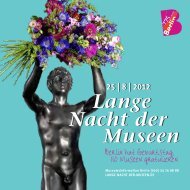1 - Lange Nacht der Museen
1 - Lange Nacht der Museen
1 - Lange Nacht der Museen
You also want an ePaper? Increase the reach of your titles
YUMPU automatically turns print PDFs into web optimized ePapers that Google loves.
116<br />
2<br />
KloSterruine<br />
View of the Klosterruine. Photograph: Ines Ebel<br />
The Franciscan monastery church was once one<br />
of the most important Gothic edifices of the city.<br />
Its ruin now rates among the oldest testimonies to<br />
medieval Berlin. Although heavily damaged during<br />
the war, the church is nowadays used for exhibitions<br />
and events.<br />
6.00 pm–2.00 am<br />
Talks, presentations and more (in German)<br />
The Klosterruine is hosting the Düppel Museum<br />
Village for the whole weekend and invites visitors<br />
to take a journey through time into the Middle<br />
Ages. For the city jubilee experts will be addressing<br />
various themes of Berlin urban settlement<br />
with talks, presentations and exhibits:<br />
• House building and village structures in<br />
the 12th and 13th centuries<br />
• Environment and Agriculture in Berlin’s<br />
environs in the Middle Ages<br />
• Everyday life in a medieval village<br />
• Technology in the Middle Ages:<br />
production of textiles and ceramics,<br />
woodwork, iron forgery, etc.<br />
around 12.00 am<br />
Film<br />
In the Kloster cinema a suprise film about<br />
the Middle Ages will be shown<br />
1<br />
KnoBlAuCHHAuS<br />
2<br />
Detail of the library in the Knoblauchhaus. © Stadtmuseum Berlin. Photograph: Richter<br />
The oldest house in the Nikolaiviertel and one of<br />
the few preserved middle-class homes from 18th<br />
century Berlin presents life in the Bie<strong>der</strong>meier period<br />
by example of the Knoblauch family.<br />
6.00 � 7.00 pm<br />
Short guided tour (in German)<br />
Welcome to the living room of the Knoblauch<br />
family<br />
The house next to the Nikolai Church is one of<br />
the few remaining civilian houses of the 18th<br />
century. The furnishings, complete with winged<br />
chair, fireplace, books and pipes, conveys the<br />
elevated life of the Bie<strong>der</strong>meier period in the early<br />
19th century. The salon and the library give the<br />
impression that the Knoblauchs have only just left<br />
the building.<br />
8.00 pm–12.00 am � hourly<br />
Music<br />
Chamber concert of Bie<strong>der</strong>meier music and<br />
retrospective of Bernhard Romberg (1767–1841)<br />
Jeannine Lungwitz (flute), Ulrike Schnelle (Violin)<br />
and Sfromine Techritz (violoncello) play works by<br />
various composers that were renowned around<br />
1820, including von Bernhard Romberg, a long-time<br />
member of the royal chapel and cellist of European<br />
standard. From 1827 onwards he organised<br />
chamber concerts of quartets and quintets in rented<br />
rooms of the first floor of the Knoblauchhaus.<br />
117



